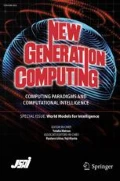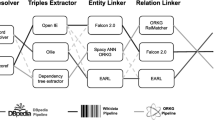Abstract
A method of representing algebraic age word problems for automated solving has been proposed. Schemas pertinent to the domain have been represented as logical predicates and functions and used as an intermediate representation. Though data-driven methods have dominated the paradigm for solving word problems recently, we demonstrate that representing these word problems formally has advantages. We illustrate that it outperforms a state-of-the-art method in terms of precision and accuracy on our newly curated and publicly available data set. Thus, we show how semantic information can improve some facets of natural language understanding.

Similar content being viewed by others
References
Bakman, Y.: Robust understanding of word problems with extraneous information. (2007) arXiv preprint arXiv:math/0701393
Berners-Lee, T., Hendler, J., Lassila, O.: The semantic web. Sci. Am. 284(5), 34–43 (2001)
Brachman, R.J., Levesque, H.J., Reiter, R.: Knowledge Representation. MIT press, London (1992)
Carlson, A., Betteridge, J., Kisiel, B., Settles, B., Hruschka Jr, E.R., Mitchell, T.M.: Toward an architecture for never-ending language learning. In: AAAI, vol. 5, p. 3. Atlanta (2010)
Dellarosa, D.: A computer simulation of childrens arithmetic word-problem solving. Behav. Res. Methods Instrum. Comput. 18(2), 147–154 (1986)
Fletcher, C.R.: Understanding and solving arithmetic word problems: a computer simulation. Behav. Res. Methods Instrum. Comput. 17(5), 565–571 (1985)
Hosseini, M.J., Hajishirzi, H., Etzioni, O., Kushman, N.: Learning to solve arithmetic word problems with verb categorization. In: Proceedings of the 2014 Conference on Empirical Methods in Natural Language Processing (EMNLP), pp. 523–533 (2014)
Koncel-Kedziorski, R., Hajishirzi, H., Sabharwal, A., Etzioni, O., Ang, S.D.: Parsing algebraic word problems into equations. Trans. Assoc. Comput. Linguist. 3, 585–597 (2015)
Kushman, N., Artzi, Y., Zettlemoyer, L., Barzilay, R.: Learning to automatically solve algebra word problems. ACL 1, 271–281 (2014)
Liang, P.: Learning executable semantic parsers for natural language understanding. Commun. ACM 59(9), 68–76 (2016)
Ling, W., Yogatama, D., Dyer, C., Blunsom, P.: Program induction by rationale generation: Learning to solve and explain algebraic word problems (2017). arXiv preprint arXiv:1705.04146
Manning, C.D., Surdeanu, M., Bauer, J., Finkel, J., Bethard, S.J., McClosky, D.: The stanford corenlp natural language processing toolkit. In: Proceedings of 52nd Annual Meeting of the Association for Computational Linguistics: System Demonstrations, pp. 55–60 (2014)
Marshall, S.P.: Schemas in Problem Solving. Cambridge University Press, Cambridge (1996)
Miller, E.: An introduction to the resource description framework. Bull. Am. Soc. Inf. Sci. Technol. 25(1), 15–19 (1998)
Mitra, A., Baral, C.: Learning to use formulas to solve simple arithmetic problems. In: Proceedings of the 54th Annual Meeting of the Association for Computational Linguistics (Volume 1: Long Papers), pp. 2144–2153 (2016)
Mukherjee, A., Garain, U.: A review of methods for automatic understanding of natural language mathematical problems. Artif. Intell. Rev. 29(2), 93–122 (2008)
Pennington, J., Socher, R., Manning, C.: Glove: Global vectors for word representation. In: Proceedings of the 2014 Conference on Empirical Methods in Natural Language Processing (EMNLP), pp. 1532–1543 (2014)
Raedt, L.D., Kersting, K., Natarajan, S., Poole, D.: Statistical relational artificial intelligence: logic, probability, and computation. Synth. Lect. Artif. Intell. Mach. Learn. 10(2), 1–189 (2016)
Robaidek, B., Koncel-Kedziorski, R., Hajishirzi, H.: Data-driven methods for solving algebra word problems (2018). arXiv preprint arXiv:1804.10718
Roy, S., Roth, D.: Solving general arithmetic word problems (2016). arXiv preprint arXiv:1608.01413
Shi, S., Wang, Y., Lin, C.Y., Liu, X., Rui, Y.: Automatically solving number word problems by semantic parsing and reasoning. In: Proceedings of the Conference on Empirical Methods in Natural Language Processing (EMNLP), Lisbon, Portugal (2015)
Singhal, A.: Introducing the Knowledge Graph: things, not strings, Official Google Blog (2012). http://googleblog.blogspot.com/2012/05/introducing-knowledge-graph-things-not.html
Smullyan, R.R.: First-order logic, vol. 43. Springer, Berlin (2012)
Stanovsky, G., Dagan, I., et al.: Open ie as an intermediate structure for semantic tasks. In: Proceedings of the 53rd Annual Meeting of the Association for Computational Linguistics and the 7th International Joint Conference on Natural Language Processing (Volume 2: Short Papers), vol. 2, pp. 303–308 (2015)
Sundaram, S.S., Abraham, S.S.: Solving simple arithmetic word problems precisely with schemas. In: International Conference on Industrial, Engineering and Other Applications of Applied Intelligent Systems, pp. 542–547. Springer (2018)
Sundaram, S.S., Khemani, D.: Natural language processing for solving simple word problems. In: 12th International Conference on Natural Language Processing, p. 390 (2015)
Wang, L., Wang, Y., Cai, D., Zhang, D., Liu, X.: Translating a math word problem to an expression tree (2018). arXiv preprint arXiv:1811.05632
Wang, L. et al.: Mathdqn: Solving arithmetic word problems via deep reinforcement learning. In: Thirty-Second AAAI Conference on Artificial Intelligence (2018)
Wang, Y., Liu, X., Shi, S.: Deep neural solver for math word problems. In: Proceedings of the 2017 Conference on Empirical Methods in Natural Language Processing, pp. 845–854 (2017)
Wielemaker, J., Schrijvers, T., Triska, M., Lager, T.: SWI-Prolog. Theor. Pract. Logic Program. 12(1–2), 67–96 (2012)
Zhou, L., Dai, S., Chen, L.: Learn to solve algebra word problems using quadratic programming. In: Proceedings of the 2015 Conference on Empirical Methods in Natural Language Processing, pp. 817–822 (2015)
Acknowledgements
We thank Tata Consultancy Services for funding this research. The first author is a recipient of the research fellowship sponsored by the same. Then, we would like to thank Prof Deepak Padmanabhan for giving exhaustive and helpful comments on our manuscript. We also thank Prof Krishna M. Sivalingam for his constant encouragement and involvement.
Author information
Authors and Affiliations
Corresponding author
Additional information
Publisher's Note
Springer Nature remains neutral with regard to jurisdictional claims in published maps and institutional affiliations.
About this article
Cite this article
Sundaram, S.S., Abraham, S.S. Semantic Representation for Age Word Problems with Schemas. New Gener. Comput. 37, 429–452 (2019). https://doi.org/10.1007/s00354-019-00069-9
Received:
Accepted:
Published:
Issue Date:
DOI: https://doi.org/10.1007/s00354-019-00069-9




